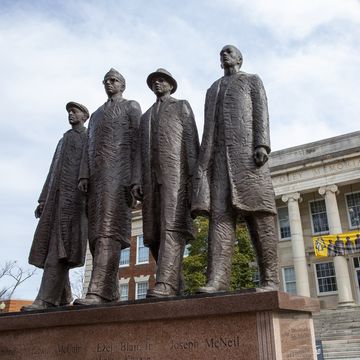The new Max original series Duster, from co-creators J.J. Abrams (Alias, Lost) and LaToya Morgan (The Walking Dead, Turn: Washington’s Spies), centers around Nina, the first Black female FBI agent who is attempting to take down a criminal syndicate in the American Southwest of 1972.
Nina, portrayed by actor Rachel Hilson, is a fictional character created for the show, which began airing Thursday. But the actual first Black female FBI agent did actually receive her badge in the 1970s. Her name was Sylvia Elizabeth Mathis, and her story took her from North Carolina to Quantico, then into the aftermath of one of the most horrific massacres of the 20th century.
The first Black FBI agent, James Wormley Jones, was appointed to the Bureau in 1919. The first female agent, Alaska P. Davidson, was hired in 1922. But it would take until 1976 for the FBI to appoint their first Black female agent.
That might have been partly to do with the fact that those aforementioned trailblazers remained the exception, not the standard, in the decades that followed. As the FBI themselves notes, when Mathis was pursuing her career with the agency, “only about 40 of the approximately 8,500 FBI agents were women; the first two female agents of the modern era—Susan Roley Malone and Joanne Pierce Misko—had earned their badges and credentials less than four years earlier.”
Another potential deterrent that must be acknowledged is the fraught, and often antagonistic, history the FBI had with the Civil Rights Movement. Wormley Jones’ work in the first quarter of the century ultimately led to the arrest of activist Marcus Garvey, who was then convicted of mail fraud despite protests that this amounted to politically motivated persecution. (Former President Joe Biden posthumously pardoned Garvey this January, nearly a century after the fact.) Decades later, the relentlessness with which FBI Director J. Edgar Hoover doggedly sought to drag down civil rights leader Martin Luther King Jr. remains, in many peoples’ eyes, a stain on the Bureau’s reputation that is still not fully understood.
To this latter point, Mathis seemed to not only be aware of that difficult history, but could also be seen as having an aim towards addressing it: “I am interested in delving into the relation of defending of rights and enforcement of rights. Going into the FBI seemed like a natural step,” she told the newspaper Virginian Pilot in February 1976.
Born on July 7, 1949, and raised in both Florida and North Carolina, Mathis obtained a political science degree from New York University. She then returned to North Carolina to earn a juris doctor from the University of North Carolina School of Law in 1975. Mathis made an impression on her dean at UNC; himself a former FBI agent, he felt Mathis had the potential, and the qualifications, to break a barrier. He encouraged her to pursue a career with the FBI, which she did, applying and getting accepted the following February.
But the application and acceptance was no guarantee that Mathis would graduate and become an agent. Training was particularly rigorous, and the FBI notes that “many aspirants, including two female African-Americans before Mathis, had not been able to complete the training.” Mathis reportedly struggled with some of the more physical aspects of the training at first, with her record indicating “difficulty in the gym and on the range.” But in time, she improved through diligent effort and determination, qualities recognized by the Bureau, which deigned to move Mathis on to graduation.
“On June 2, 1976,” the FBI writes, “FBI Director Clarence Kelley presented Special Agent Sylvia Mathis with her badge and credentials, #2658. She was issued a leather attaché case, an unadorned purse, and a Smith & Wesson revolver with a snub-nosed barrel short enough to fit inside the purse.” Five days later, she turned 27.
Mathis was first assigned to the organized crime squad at the FBI’s New York field office, but perhaps her most notable assignment arrived in 1978. Mathis was one of the agents tasked with interviewing survivors of the infamous massacre in Jonestown, Guyana. Mathis’ involvement in this particular investigation was important: under-remarked upon in much of the media involving the horror of Jim Jones’ cult is the fact that Black women made up 45 percent of the population of Jonestown, according to San Diego State University, and Black men another 23 percent.
The following year, Mathis left the FBI. She initially worked as an attorney in New York, before relocating to Jacksonville, Florida, in order to be closer to family. There, Mathis became the director of the Jacksonville Downtown Ecumenical Service Council, which an article from UNC describes as providing “support to homeless and unemployed residents of the city.” Mathis’ work earned her the title “Ms. Metro” in the Jacksonville newspaper The Metropolis. One of her colleagues told the paper, “She is a very caring person and has given a lot of her time to those who need help.”
Her time was tragically cut short, however. In 1983, 34-year-old Mathis was killed in a car accident. Although her tenure with the Bureau was brief, her tenacity and trailblazing efforts still provide a guiding light for anyone hoping to pursue their own careers in otherwise uncharted law enforcement territories.
Watch Duster on Max
The first episode of the fictional new show, starring Rachel Hilson and Josh Holloway, dropped Thursday, May 15, on Max. Additional episodes release every Thursday at 9 p.m. ET through the finale on July 3.
Michale Natale is a News Editor for the Hearst Enthusiast Group. As a writer and researcher, he has produced written and audio-visual content for more than fifteen years, spanning historical periods from the dawn of early man to the Golden Age of Hollywood. His stories for the Enthusiast Group have involved coordinating with organizations like the National Parks Service and the Secret Service, and travelling to notable historical sites and archaeological digs, from excavations of America’ earliest colonies to the former homes of Edgar Allan Poe.














